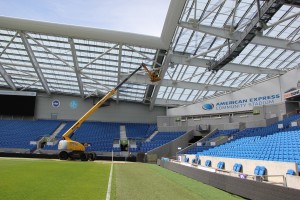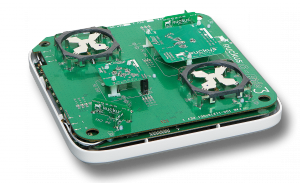
Alexa Barnes walked into the Safeco Field, home of the Seattle Mariners, to watch a baseball game. She bought some garlic fries and a drink on the way to her seat. Then she connected to the stadium Wi-Fi before uploading a picture to Instagram.
Between innings, she usually browses through social media. Barnes and her friends have also taken a special interest in the #gomariners hashtag because the screen at the stadium displays Instagram photos from fans.
Sports stadiums are experiencing decreased attendance at games. In an effort to increase attendance, many stadiums are installing high-speed wireless Internet so fans can still interact easily with social media during games.
Decreased attendance
The Wall Street Journal reported in 2014 that average student attendance at college football games had decreased 7.1 percent since 2009.
Possible explanations for lower attendance include costs and weather, as well as the fans ability to watch the game comfortably from home on a big screen TV with instant replays and fast Internet at the touch of a finger.
The need for Wi-Fi
As fast Internet connections have become an expectation of consumers, companies have worked to deliver that speed.

Ruckus Wireless, headquartered in Sunnyvale, California, supplies advanced wireless systems globally. Hotels, schools, train stations and stadiums are all home to Ruckus Wireless’s technology.
“The public has come to expect Wi-Fi wherever they go, but the mobile phone networks aren’t designed for it,” said David Callisch, vice president of corporate marketing for Ruckus Wireless. “What we have done is invest heavily in next generation Wi-Fi for both indoor and outdoor systems.”
Ruckus Wireless has outfitted the Anaheim Angels, the Sacramento Kings, the Time Warner Center in North Carolina and World Cup soccer stadiums, just to name a few. Ruckus Wireless also installed networks in the American Express stadium in the United Kingdom and in locations throughout India, Europe and Asia.
“The demand for data capacity in the wireless networks has overwhelmed today’s current network infrastructure, even with 4G,” Callisch said. “As the market for smartphones and devices has grown, it has exploded. Everyone now has more than one device — a tablet, iPhone, laptop —and guess what they all want? Wi-Fi.”
Stadiums advertise free Wi-Fi and even design custom apps for phones so audiences can view replays and statistics and even order food.
“We try to improve the fan experience because these teams want to get closer to the customer, the fan, and want to engage with the fan,” Callisch said. “They want to sell them stuff, talk to them and have a relationship.”
DAS—improved cell phone service
Many stadiums are also choosing to use Distributed Antenna Systems (DAS) as an option for better connectivity for fans. A DAS will simply distribute cell phone signals over a larger area, which is helpful in a stadium that generally has poor service because it is overloaded with users.
Bad service has been a deterrent and a danger in many locations.

While the Energy Solutions Arena in Salt Lake City is not equipped with Wi-Fi for fans, the facility does provide service through a DAS.
“In April of 2014, we made an announcement that we had selected Boingo Wireless as the exclusive DAS partners so that gave us a neutral host network that has enhanced the fan experience at Energy Solutions Arena,” Frank Zang, spokesperson for the Energy Solutions Arena said.
Though it has a DAS, Energy Solutions Arena is one of only six NBA arenas without fan-facing Wi-Fi, according to the March 2014 Stadium Tech Report.
“We place great value on the fan experience from when you park your car and enter into the building, to our food services and our technology,” Zang said. “We recognize that many fans have handheld devices that they use to complement their experiences and so it is important for us to have a robust system in place. We do have Wi-Fi service, but it is designated for specific user groups such as the media and our employees.”
Rankings continue to be positive despite the lack of Wi-Fi. The Jazz continue to be in the top 10 teams in the NBA for average home attendance. Last season the Jazz ranked tenth with 41 home games and an average attendance of 18,830 at home. The year before, the Jazz ranked twelfth in the league with an average of 18,175 in attendance, Zang said.
“We always look for ways to improve, which would include digital services in the future,” Zang said.
Beginning to implement in Utah
Despite rumors of Wi-Fi being installed in the LaVell Edwards Stadium, BYU currently has no plans to do so, according to spokesperson Todd Hollingshead. However, BYU is working with cellular providers to improve coverage in the stadium.
The University of Utah is known to have Wi-Fi at the Rice-Eccles Stadium, but it is simply the campus Wi-Fi that extends down to the stadium, said Zachary Lowder, who works in the department that maintains the stadium and arena.
“We utilize the on-campus group IT team to maintain our Wi-Fi stadium,” Lowder said. “We’ve just expanded as the years go on.”

Students use their student ID to log in, and there is a guest account option for visitors.
“Lack of Internet is one of many reasons why people don’t attend,” Lowder said. “Parking, getting to the venue, restrooms and other services in the venue can all deter them.”
About two years ago, a system was installed for Verizon customers which has helped with cell service.
“It’s not perfect when full capacity but still allows you to get a text out which is better than it was before,” Lowder said.
How the fans like it
Alexa Barnes attends a Seattle Mariners game about once every two weeks during the season, and while there she enjoys the provided Wi-Fi.
Even though instant replays and texting are made easier because of Wi-Fi, the biggest advantage for fans appears to be the ease of posting to social media.
“It’s nice that it actually works from where you’re sitting and you don’t have to wait till you get home to post something,” Barnes said. “At busy games that are full, having Wi-Fi allows using iMessage or makes Facebook messaging easier.”




